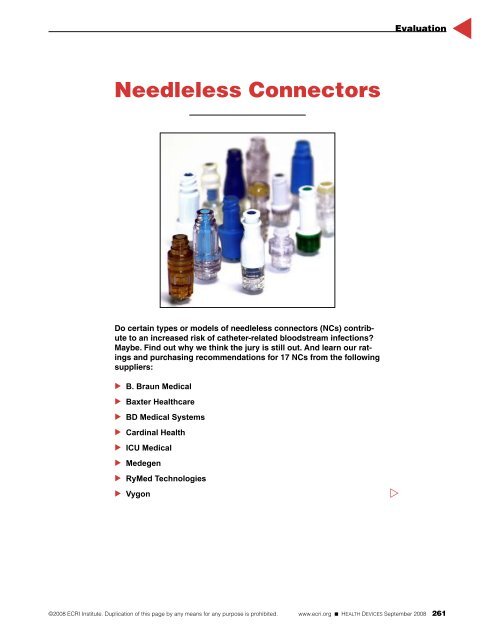Needleless Connectors And Clabsi
Curos disinfection caps may contribute to the prevention of CLABSIs and CRBSIs as part of a bundle of infection prevention processes. Two 500-bed university hospitals patients.
Accessing the Needleless Connector Performing proper hand hygiene Vigorously scrubbing the needleless connector or hub for 15 seconds with chlorhexidine povidone iodine an iodophor or 70 alcohol every time you make or break a connection Allowing equal time for drying.

Needleless connectors and clabsi. In pediatric SCT patients changing needleless connectors every 24 hours when blood or lipids are infused is associated with increased CLABSI rates. Needle-free connectors NFC have been suggested to reduce the rate of bacterial contamination and subsequent catheter-related bloodstream infection CRBSI but data remains ambiguous. Curos is a single-use device that contains a foam that is impregnated with 70 isopropyl alcohol.
Prospective longitudinal observation study SETTING Two 500. Needleless connectors with neutral or positive displacement of blood at the time of deaccessing the connector appear to have lower CLABSI risk than negative displacement connectors. To assess the impact of a novel silver-coated needleless connectors NCs on central-lineassociated bloodstream infection CLABSI rates compared with a mechanically identical NCs without a silver coating.
Manufacturers designed needleless connectors NCs to reduce needlestick injuries and exposures to bloodborne pathogens. Gnass Infection Preventionist for her assistance in. Process measures associated with catheter maintenance were not addressed.
In pediatric SCT patients changing needleless connectors every 24 hours when blood or lipids are infused is associated with increased CLABSI rates. National recommendations regarding NC change frequency should be clarified. Proper catheter care and Acknowledgement The author would like to acknowledge Sylvia I.
Thus we tested if a novel NFC would reduce bacterial contamination and. To assess the impact of a novel silver-coated needleless connectors NCs on central-line-associated bloodstream infection CLABSI rates compared with a mechanically identical NCs without a silver coating. However studies suggest that this may not be performed consistently and that the practice may be less effective than other methods of reducing contamination of needleless ports.
Intravenous needleless connectors NCs with a desired patient safety design may facilitate effective intravenous line care and reduce the risk for central lineassociated bloodstream infection CLA-BSI. Change needleless connectors no more frequently than every 72 hours or according to manufacturers Recommendations for the purpose of reducing infection rates. The aim of this study is to evaluate the management of the collection of BC and needleless connector NC cultures to study the impact on the diagnosis of CLABSI.
National recommendations regarding NC. The literature suggests that placing disinfectant caps over needleless connectors decreases CLABSI risk. The study suggests Gram positive bacteria as the most representative microorganism recovered from the NCs being identified only once in the CVC-line.
Swabable positive displacement needleless connector may assist in reducing microbial contamination and thus the occurrence of CLABSI however additional research is necessary in this area. Needleless connectors including the standard split septum and the luer-activated mechanical valve connectors have been introduced into clinical practice to eliminate the risk of needlestick. Change the needleless components at least as frequently as the administration set.
Use of Curos is claimed to avoid the need to manually disinfect needleless connectors. As healthcare facilities began to strive for zero. However the evidence for Curos is limited in both quantity and quality and may.
All NCs displace fluid and most do not control fluid movement. Prospective longitudinal observation study setting. Needleless connectors are thought to be a source of CLABSI.
The standard protocol to prevent port derived CLABSI is to scrub the hub with an isopropyl alcohol impregnated wipe. We conducted a meta-analysis to determine the risk for CLA-BSI associated with the use of a new NC with an improved engineering design. A quasi-experimental intervention study was conducted in a 430-bed trauma I center.
There is no benefit to changing these more frequently than every 72 hours. In addition to an existing standard central line bundle a new intervention consisting of a luer-lock disinfectant cap with 70 alcohol was implemented in all intravenous IV needleless connectors. Although needleless connectors NC have been used for well over a decade and are recognized portals of entry for microbial contamination the initial patient safety initiatives for CLABSI reduction focused on central line insertion practices.
Impact of needleless connector change frequency on central line-associated bloodstream infection rate. One CLABSI prevention method is disinfection of intravenous access points. Needleless Connectors and CLABSI prediction.

1 Hand Hygiene 2 V Appropriate Hand Hygiene

Needleless Connectors Iv Therapy
Https Www Bd Com Documents International Brochures Infusion If Maxplus Br En Pdf

Hickman Catheter And Needleless Connectors Download Scientific Diagram
